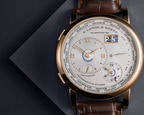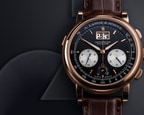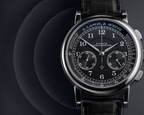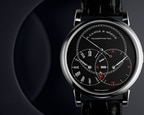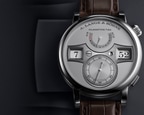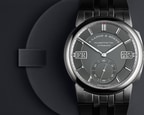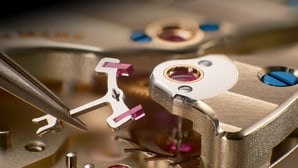The ZEITWERK MINUTE REPEATER is the first A. Lange & Söhne model that strikes the hours, ten-minute intervals, and minutes. Its acoustic indication corresponds exactly with the digital display. A low-pitched tone for each elapsed hour, a double tone for each elapsed ten-minute period and a high-pitched tone for each elapsed minute. As soon as the striking mechanism is activated with the repeater pusher at 10 o’clock, the hammer on the left strikes the hours, the one on the right the single minutes; for the double-tone ten-minute intervals, both hammers strike their respective gong slightly offset in time.
An innovative concept
While developing this minute repeater, Lange’s designers ventured into uncharted horological territory because all previously known minute repeaters were integrated in analogue watches. Conversely, in the ZEITWERK MINUTE REPEATER, it was necessary to couple the minute repeater with the movement of a digital-display timepiece. The engineers not only mastered this challenge but also found a solution that relies on the principle of the jumping numerals mechanism.
Three snails connected with the mechanical display elements sample the time to be struck. The hours are sampled on the outer circumference of the hour ring in which the twelve-step hour snail is integrated. The tens-minute snail and the minute snail are connected with their assigned minute discs as well. They are arranged on two separate axes and have ten and six steps, respectively. The configuration and shape of the three snails with relatively large sampling surfaces make it possible to decode the time in a dependable and error-free manner.
1 Mainspring barrel
2 Ratchet wheel
3 Hour gong
4 Hour gong hammer
5 Hour snail
6 Tens-minute snail
The decimal minute repeater
In ordinary minute repeaters, the energy needed for the striking mechanism is delivered by a separate spring barrel. Prior to any striking sequence, it must be tensioned with a slide in the case flank. The ZEITWERK MINUTE REPEATER takes the energy needed by the striking mechanism directly from the mainspring barrel. When the strikework is activated, the ratchet wheel is uncoupled from the winding train. Therefore, the ratchet wheel can turn freely and power the striking mechanism. This also prevents the winding train including the crown from turning during the repeater sequence, which would imply a loss of energy. The mechanism that uncouples the winding train is one of a total of five patented features in this movement.
Elaborate safety mechanisms
To guarantee the flawless interaction of the complex mechanical ensemble, elaborate safety and blocking mechanisms have been integrated into the movement. While the repeater is working, the switching action of the numerals discs is delayed. At the same time, the crown cannot be pulled and consequently, the time cannot be set. This precaution prevents any interference with the strikework sampling sequence and ensures that the acoustic indication of time precisely corresponds with the digitally displayed time. The maximum number of 31 strikes at 12:59 (twelve low tones for the hours, five double strikes for the ten-minute intervals, and nine high tones for the single minutes) takes about 20 seconds to execute. If a new minute begins while the repeater is striking, the minute and/or hour jump is performed immediately when the tone sequence has ended. Thereafter, the next numeral disc switching cycle takes place with the regular timing when the continuously running seconds hand passes the 60-seconds mark.
Since the mainspring drives the striking mechanism, the number of minute repeater sequences and their duration influences the residual power reserve. To assure that the repeater sequence is not prematurely interrupted and the watch inadvertently stops running, the striking mechanism can no longer be activated if the remaining power reserve is less than twelve hours. This blocking mechanism is activated when the power-reserve indicator reaches the red marker.
The quest for the perfect sound
To achieve the best possible sound quality, the engineers systematically optimised the movement and the case. Instead of a slide, the ZEITWERK MINUTE REPEATER features a pusher for activating the striking mechanism. This approach protects the watch against the ingress of water at pressures of up to three bar.
The tuning of the gongs calls for a trained ear and is performed exclusively by hand. In the watch, the gongs must reverberate clearly and harmonise with one another to perfection. They are disassembled, retuned, reassembled and tested several times to achieve this result. The quest for the perfect sound accounts for much of the total assembly time.
Explore further




